
Recently on Cyclingnews.com |
Tech review - January 25, 2005
Fondriest Luxter
The real thing
Maurizio Fondriest was one of the top Italian Classics riders of the 90s before hanging up his wheels and turning to bike design and manufacture. He now runs Biciclette Fondriest with his brother Francesco, who was himself no slouch as a top amateur rider, and who loaned us his own Luxter for this test. Les Clarke took it for a spin.
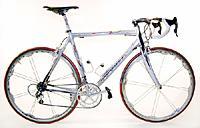
|
Fondriest is a name associated with success. As a rider, Maurizio Fondriest won Milan San Remo and the World Cup in 1991. Like Eddy Merckx before him, Fondriest then established a bicycle company that has carved out a relatively small but highly-regarded niche with a reputation for making quality bikes. You won't find Fondriests under many pro riders, but the marque has its adherents around the world. Francesco Fondriest (Maurizio's brother) gave us his own Luxter to test, and this model is a direct descendant of the top-level TF1 model used by the Cafés Baque pro team. The carbon fibre used is almost identical to its more illustrious stablemate, but the lines of the TF1 are slighter cleaner and leaner.
Fondriest is a big believer in monocoque construction of carbon fiber frames, and the main difference between the TF1 and the Luxter are in the drop-outs (aluminium rather than the TF1's carbon fiber) and the density of carbon in the lay-up. These differences make the Luxter a little quicker and therefore less expensive to manufacture, but the final step is the same: the whole frame is laid up in a mould, and subjected to heat and pressure to cook the resin. The result is that the final frame is one continuous structure. The Luxter we tested was finished in silver with red graphics, a style Fondriest calls 'Red Lux '; it's also available in finishes based on red and blue carbon. It's a striking look - and some of Fondriest's other colour schemes are even more distinctive - but the general consensus being a big thumbs up to the silver machine.
The Luxter's tubes are somewhat oversized - bigger that those on some Look frames, for example, but smaller than a Scott CR-1's or the aluminium tubes of a Cannondale. The result is a frame that's stiff but not excessively so - there's a still a tiny bit of shock-damping flex there and of course you have the well-known shock-absorption properties of carbon fiber helping smooth the ride.
The Frame
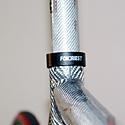
|
The Luxter comes in five sizes: extra small, small, medium, large and extra large. This type of sizing scheme is increasingly common, especially with monocoque carbon frames where the cost of moulds makes offering a multitude of sizes prohibitively expensive. However, it can mean that some people simply won't be able to get such a frame that fits them perfectly.
Our sample was a large, though in a perfect world I'd have been on a medium (but when you're offered the company owner's own bike it's hard to be picky) and had a 57.5cm seat tubes (measured centre to top) , 56.3cm effective top tube, 73.3 degree seat tube, and 73.5 degree head tube. It's obvious that a lot of work and thought has gone into the design of the Luxter frame. The chainstay and bottom bracket areas in particular are highly shaped, with lots of material around the bottom bracket shell itself, and complex, 'flattened s-bend' chainstays wending their way through an area of the frame where there isn't much space between the tyre and chainrings.
Components
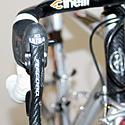
|
Francesco Fondriest's Luxter runs, unsurprisingly, a full Campagnolo Record group. My own far more humble rig has Campagnolo Veloce, so the switch didn't involve relearning shifting the way moving between Campagnolo and Shimano does, and I found changing itself to be a pleasure. The gear-to-gear click-click of Record was smooth and easy - noticeably more so that my Veloce set, which can be a bit clunky. Also found no need to make little adjustments to the front derailleur according to which gear on the cluster I was in - this is something I have to do when changing on my own bike. The braking with Record was excellent - I really enjoyed knowing that I had the hardware to pull me up if I needed it in a hurry. It's been said before, but this is a standout area of the Record group, and something I constantly noticed when it got me out of trouble.
Record's other big bonus is the amount of weight-saving carbon scattered through the components. Maybe I'm easy to please, but the carbon brake levers and rear derailleur cage never ceased to impress me - not just the fact that they saved weight, but because they look good every time. However, Francesco has gone for the heavier aluminium version of the Record chainset - still a lovely piece of kit though, and I didn't lose any sleep thinking about the extra few grams I was carrying!
Finishing kit
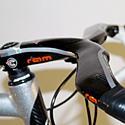
|
The Cinelli RAM one-piece carbon fiber bar and stem is an intriguing component. It's significantly lighter than most bolt-together bar and stem combinations, and I found that anatomic bend in the drops was really comfortable, making riding in them more fun than I should probably admit to! On the other hand, the one-piece design means changing the stem length to tailor the fit is impossible, and you also can't change the angle of the bar - I found my wrists getting tired on climbs because the shape just wasn't quite right for me.
I had no problems with the Selcof silver carbon seat post - more weight savings - but I did find the Fizik Arione saddle didn't fit my butt properly. Francesco Fondriest - and many other satisfied cyclists, it seems - obviously have a different physiology to mine, and this area of any bike is always about individual fit. No complaints about flexing here either, which is definitely a good thing. The Gipiemme Parade wheels were shod with Vredestein Fortezzas - not lightweight, but they did the job well, and were colour co-ordinated to the rest of the bike.
The Ride
My usual ride is also Italian, but it's aluminium, and the improvement in comfort that comes from a lighter, carbon fiber frame was the first aspect of the Luxter I noticed on the road. A lot of the riding for this test happened on country roads around my family's home in Bathurst, New South Wales. Riding on country roads can be a hazardous exercise for your posterior as most of the surfaces are made from larger-aggregate bitumen, and road buzz is a big factor. I didn't notice much buzz at all, and when I punished the bike a little on some rough patches the local council still hadn't mended, the ride was pretty unaffected, except for some for the inevitable jolting through the bars.
That was the recurring thought: 'how am I going to return to an aluminium bike where the only bit of carbon on it is the forks?'
The country roads I rode were also littered with great hills, and it's here that I had the most fun on the Luxter. It helped me cheerfully dispose of two kilometre climbs, even with my varying level of fitness over the course of the test. I like climbing standing on the pedals, and the fact that the saddle wasn't quite right for that particular part of my body (it's always a personal thing) meant that I was attempting my version of the Lance Armstrong high-cadence dance whenever the roads pointed upwards. In these cases I found the Luxter to be a more than willing dance companion. The hills in the upper northern reaches of Sydney provided me with another good test of the Luxter's climbing ability, and again I was impressed with the fact that you could easily spend a lot of time going upwards, which sounds masochistic, but it was quite enjoyable on this bike. This was due to the relatively low weight and comfortable position - although the frame was a little big I was nevertheless able to get a relaxed position and get the power out on climbs.
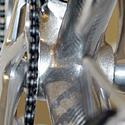
|
I rode the Luxter on the famed Mt Panorama racing circuit in Central Western NSW several times during the test and found it strong on the climb (short, sharp and painful the third or fourth time round) and very capable on the descent, especially on one corner named 'The Dipper'. This corner drops very quickly as you turn, and tests the ability of rider and machine well. The confident performance was a result of the responsiveness of the bike when turned into a corner, and the braking of the Record groupset, which I found time and again to be excellent. I was really impressed by the stopping power of the Record brakes; yet they maintained a 'calmness' when I needed to brake quickly.
The responsiveness of the frame was something I really enjoyed when riding - putting it into corners on a criterium or on a descent felt nimble but sure, even when I hadn't ridden the corner before. The Mt Panorama track is an excellent mixture of riding pain and pleasure - the only part of the Luxter's performance on it I was a little disappointed with was a slight dull feel on the flat parts of the circuit; but I suspect this may be a result of wheel choice on the test machine. The Gipiemme Parade wheels, although attractive due to their paired spoking and flared rim outlets for these spokes didn't match the quality of the frame. They didn't provide the stiffness I was looking for, and this may have affected my enjoyment on the bike. I would opt for a stiffer wheelset on this frame, and chances are you may get closer to full potential of the bike. This may be the area where the lack of stiffness I complained of was originating from, not the frame itself.
Conclusion
The Luxter is a bike that offers a really comfortable ride without making too many sacrifices in terms of weight. Stiffness was an issue at times, but with a rigid set of wheels that issue should be well and truly minimised. If you plan on doing big hours in the saddle, this bike would probably suit you very well. It's not cheap, and keeping the costs down by using a group without the same price tag as Record should help there. A solid performer with plenty to offer, the Luxter is definitely an option if you've got the cash.
Pro: Italian class, comfort without adding too much weight
Con: Size range may not suit everyone, quite pricey
Cyclingnews Rating: ![]()
Full specification: Fondriest LuxterFrame: Luxter Carbon Fibre – silver carbon layer Cranks: Campagnolo Record aluminium 39-53 More information: Fondriest website |
RRP (frame only): US$3,299Wheels: Gipiemme 16h paired front 16h paired rear 700x23c Stem: - Pedals: Not included |

